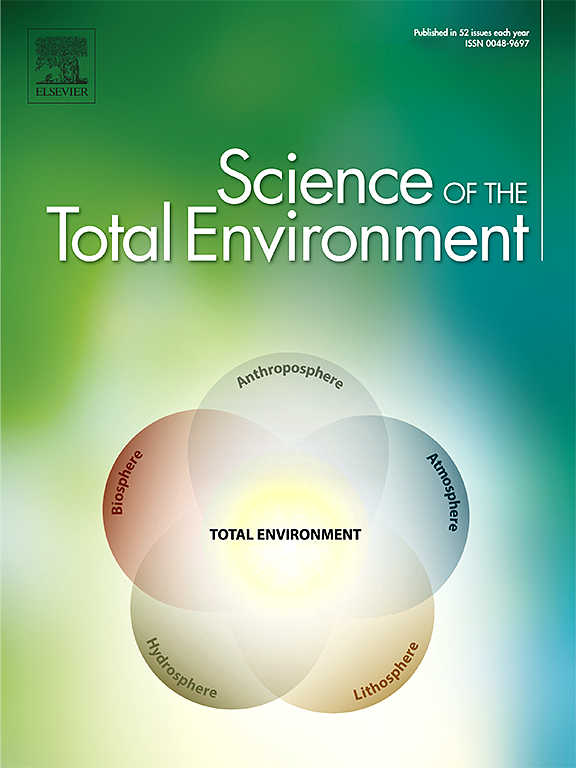固定化降解酶降解磁性发酵残渣生物炭中PGNa的机理。
IF 8.2
1区 环境科学与生态学
Q1 ENVIRONMENTAL SCIENCES
引用次数: 0
摘要
开发一种从环境中有效去除高浓度青霉素G钠(PGNa)的方法对人类和动物的健康和安全至关重要。本研究采用青霉素发酵废渣中的生物炭吸附固定化降解酶,在20 min内可有效去除900 mg/L的PGNa,去除率达99.84%。通过扫描电镜、傅立叶红外光谱和热重分析仪验证了固定化PGNa降解酶的成功。通过吸附动力学和分子对接计算分析了SAMB在酶上的吸附机理,主要是化学吸附和物理吸附。通过与游离酶的比较,发现固定化酶具有更好的热稳定性、pH适应性、可重复使用性和储存稳定性。此外,结合对去除产物的LC-MS分析,假设了三种去除途径,包括β-内酰胺环裂解、脱羧、去甲基化、脱酰胺和氧化反应。最后利用ECOSAR软件对去除产物进行毒性评价,结果表明中间产物毒性较低。本研究首次使用青霉素废渣固定化降解酶去除PGNa,为修复环境中PGNa污染提供了一种新的低成本选择。这对于有效降解环境中残留的PGNa具有重要意义。本文章由计算机程序翻译,如有差异,请以英文原文为准。

Degradation mechanism of PGNa by the immobilized degrading enzymes from magnetic fermentation residue biochar
The development of a method to efficiently remove high concentrations of penicillin G sodium (PGNa) from the environment is important for human and animal health and safety. In this study, the degradative enzymes were immobilized by adsorption using biochar from penicillin fermentation waste residue, which could efficiently remove PGNa (900 mg/L) from an aqueous solution, with a removal rate of 99.84 % within 20 min. The successful immobilization of the PGNa-degrading enzymes was verified by scanning electron microscopy, Fourier transform infrared spectroscopy and thermogravimetric analyzer. The adsorption mechanism of SAMB on the enzymes was also analyzed by adsorption kinetics and molecular docking calculations, which were mainly chemisorption and physisorption. By comparing with the free enzymes, the immobilized enzymes were found to have better thermal stability, pH adaptability, reusability, and storage stability. In addition, combined with the LC-MS analysis of the removal products, three removal pathways were postulated, including the reactions of β-lactam ring cleavage, decarboxylation, demethylation, deamidation, and oxidation. Finally, the toxicity of the removal products was evaluated using ECOSAR software, and the results showed that the intermediate products had low toxicity. This study is the first to use penicillin waste residue immobilized degradative enzymes to remove PGNa, and it provides a new low-cost option for remediation of PGNa contamination in the environment. It is important for the efficient degradation of residual PGNa in the environment.
求助全文
通过发布文献求助,成功后即可免费获取论文全文。
去求助
来源期刊

Science of the Total Environment
环境科学-环境科学
CiteScore
17.60
自引率
10.20%
发文量
8726
审稿时长
2.4 months
期刊介绍:
The Science of the Total Environment is an international journal dedicated to scientific research on the environment and its interaction with humanity. It covers a wide range of disciplines and seeks to publish innovative, hypothesis-driven, and impactful research that explores the entire environment, including the atmosphere, lithosphere, hydrosphere, biosphere, and anthroposphere.
The journal's updated Aims & Scope emphasizes the importance of interdisciplinary environmental research with broad impact. Priority is given to studies that advance fundamental understanding and explore the interconnectedness of multiple environmental spheres. Field studies are preferred, while laboratory experiments must demonstrate significant methodological advancements or mechanistic insights with direct relevance to the environment.
 求助内容:
求助内容: 应助结果提醒方式:
应助结果提醒方式:


